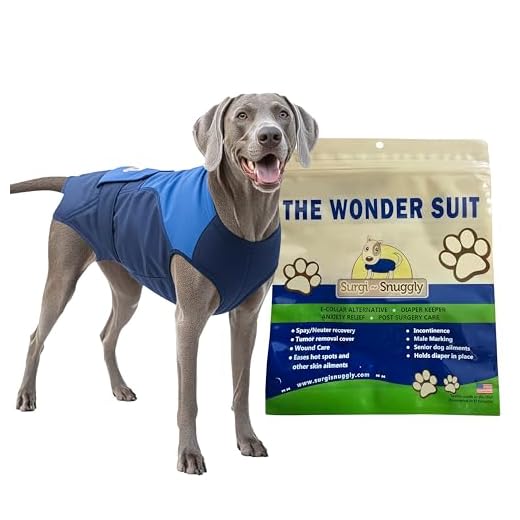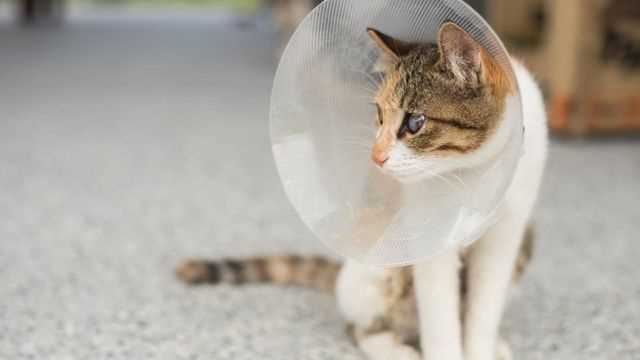



The recommended timeframe for wearing a protective device following a surgical procedure is typically 10 to 14 days. This duration allows for adequate healing of the incision site, minimizing the risk of complications such as infection or opening of stitches.
During this period, vigilant monitoring is essential. If any signs of distress or irritation arise, consult a veterinarian immediately. Regular checks can help ensure that the device is not causing any discomfort or hindering movement.
In the event of excessive licking or biting at the area, the protective device must remain in place until the surgical site shows significant improvement. Always follow the advice of your veterinary professional for the best outcomes.
Duration for E-Collar Usage Post-Operation
For optimal recovery, wearing the e-collar for 10 to 14 days is generally recommended. This timeframe allows for proper healing of the surgical site.
Here are key points to monitor during this period:
- Check for signs of irritation or discomfort.
- Ensure the collar fits snugly but isn’t too tight.
- Observe the incision for any unusual swelling or discharge.
If I attempt to lick or scratch the area, it’s crucial to ensure I remain in the collar for the full duration. If my behavior changes drastically or if there are concerns, consulting a veterinarian is advisable.
After the initial 10-14 days, a follow-up check with the vet can determine if it’s safe to remove the collar. Each recovery process is unique, so adjustments may be necessary based on individual healing rates.
Understanding the Spaying Process and Recovery Timeline

Immediately following the procedure, I was groggy but stable, thanks to the veterinary team. The initial 24 hours are critical for rest; my humans monitored my behavior closely. During this time, I was encouraged to remain calm and avoid jumping or playing, which could hinder healing.
For the next few days, it was essential to observe for any unusual signs. Mild swelling or slight discharge is normal, but anything excessive warrants a trip back to the vet. My humans kept track of my appetite; a decrease is common, but they ensured I stayed hydrated.
After the first week, I felt more like myself. My stitches were checked, and I was cleared for light activity. However, my humans still restricted my movements to prevent any complications. They were diligent about keeping my environment quiet to minimize stress.
By the second week, I was nearly back to normal. My energy returned, and my curiosity kicked in. That was the time my humans began to gradually reintroduce play while still supervising me closely. They understood that even though I was feeling better, the recovery process wasn’t entirely over.
Typically, complete recovery takes about 10 to 14 days. By then, I was fully active again, ready to reclaim my space and enjoy life without restrictions. The experience taught my humans about the importance of patience and careful observation during recovery.
Signs Your Feline Friend Needs Extended Recovery Protection
Persistent licking or biting at the surgical site indicates discomfort or irritation, suggesting a longer duration with protective gear is necessary. Watch for any redness, swelling, or discharge around the incision; these symptoms could signify infection, warranting additional time in a protective device.
Changes in behavior, such as increased agitation or attempts to escape confinement, may reflect anxiety about the healing process. If your furry companion seems overly restless or distressed, it’s wise to consult with a veterinarian about potentially extending the use of recovery aids.
If your beloved pet exhibits unusual lethargy or lack of appetite, this could signal complications that require more vigilant care. Monitoring their eating and activity levels is crucial; a decrease in these areas might necessitate keeping the protective device in place longer.
Should the incision site remain sensitive to touch, or if your pet flinches away when you gently inspect the area, this could indicate ongoing discomfort. Consulting a vet to assess the situation may lead to recommendations for prolonged use of the recovery device.
In case of any unusual vocalizations or signs of pain, such as yowling or hiding, these may point to the need for extended protection. It’s essential to address these signs promptly with a veterinary professional to ensure a smooth recovery.
What to Expect During the First Few Days Post-Surgery

In the initial days following my procedure, it’s crucial to monitor my behavior closely. Expect some lethargy; this is normal due to anesthesia effects. I may also show reduced appetite, but it’s essential to encourage eating small amounts of my usual food.
Behavioral Changes
During recovery, I might be less playful and prefer resting. It’s important to provide a calm environment. If I seem overly agitated or distressed, consult a veterinarian. Be aware of my grooming habits; I may try to lick the surgical site, which is why protective measures are necessary.
Health Monitoring
Keep an eye on my incision site for any signs of infection, such as swelling, redness, or discharge. If any of these occur, reach out to a vet immediately. Hydration is also vital; ensure I have access to fresh water at all times.
| Signs to Watch For | Action to Take |
|---|---|
| Excessive Lethargy | Contact a veterinarian |
| Poor Appetite | Encourage small meals; consult if prolonged |
| Incision Issues | Seek veterinary advice immediately |
| Vomiting or Diarrhea | Consider the best anti diarrhea medicine for cats and consult a vet |
Recovery can vary, but with attentive care, I’ll soon be back to my usual self. Your support is key during this time.
Monitoring Your Feline Friend’s Behavior with the Protective Device
Pay attention to your companion’s movements and interactions. If they seem unusually lethargic or refuse to engage in typical activities, this might indicate discomfort or stress from the new addition.
Watch for changes in eating and drinking habits. A decrease in appetite or reluctance to hydrate can signal an issue. Ensure food and water are accessible and encourage them to eat and drink.
Observe grooming behaviors. If your furry friend attempts to lick or bite the surgical area, they may be feeling the urge to reach that spot despite the barrier. This could mean the protective device isn’t effective or requires adjustments.
Behavior towards you is also important. If they seem more irritable or withdrawn, this might be due to frustration from the device. Spend time with them to provide comfort and reassurance.
Keep an eye on their litter box habits. A sudden change in bathroom behavior, like straining or avoiding the litter box, could be a sign of discomfort or distress. Regular check-ins can help you catch any issues early.
Document any significant changes in behavior. This information can be useful for discussions with the veterinarian if concerns arise.
Lastly, ensure that the protective device fits appropriately; it should restrict access without causing pain or discomfort. Adjustments may be necessary as they heal. Regularly check for signs of irritation or chafing around the neck area.
When to Consult a Veterinarian About the Duration
If you notice excessive licking or biting at the surgical site, seek professional advice immediately. Persistent signs of discomfort or distress, such as vocalization or refusal to eat, warrant a visit to the vet. Monitoring for swelling, redness, or discharge around the incision is crucial; any of these symptoms should prompt a consultation.
After the procedure, regular check-ins with your veterinarian can help establish a baseline for recovery. If your human has concerns about the effectiveness of the protective measure, discussing options with the vet can provide clarity. Sometimes, an extension in wearing the protective device may be necessary if healing is slower than expected.
Pay attention to behavioral changes. If I seem unusually withdrawn or exhibit signs of pain, it’s best to reach out for advice. Quick action can prevent complications and ensure a smoother recovery. For those with larger pets, exploring resources like best acl surgery for large dogs can offer additional insights into post-surgical care.
Ultimately, trust your instincts. If something feels off, reaching out to a veterinarian for guidance is always a wise choice.








